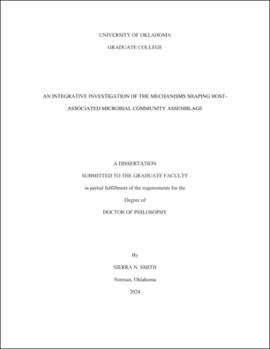| dc.description.abstract | A critical goal of biologists is to describe the diversity of organisms on the planet and to illuminate the evolutionary processes that have shaped the global biodiversity we observe today. This is often accomplished by exploring diversity at a single scale such as the diversity of microorganisms within a soil sample or the number of plant species within an area of grassland. However, integrating across biological scales can generate a more comprehensive understanding of our planet’s biodiversity. My research employs a holistic approach to investigate how differences at the organismal, community, and landscape levels drive variation at the microscopic level. This is made possible through the use of genomic approaches. Genomics is the study of an organism’s genes (i.e., DNA) and, using genomic methods, I isolated the genetic material of microorganisms found within different areas of the focal vertebrate host organisms, specifically reptiles and amphibians. These communities of microorganisms are referred to as microbiomes and they serve fundamental roles in numerous processes that benefit their hosts, including digestion, metabolism, and immunity. Given the critical roles that microbiomes play in modulating host health and persistence, understanding the environmental and evolutionary processes that shape host-associated microbial communities remains critical as the planet’s biodiversity continues to face threats posed by rapid environmental change, habitat modification, and emerging infectious diseases. Through three chapters, my dissertation research investigates if factors such as host evolutionary history, host ecology, pathogen presence, geographic location, and island size contribute to variation in vertebrate microbiome diversity, applying fundamental theories in ecology, evolutionary biology, and biogeography to further explore the mechanisms that shape host-associated microbiomes. To date, most vertebrate microbiome research has focused on humans and other mammals; however, increased availability and utilization of genomic techniques has expanded our knowledge of the diversity, structure, and functional capabilities of these microbial communities and has increased the taxonomic scope of microbiome studies to include more vertebrate taxa such as birds, fishes, amphibians, and reptiles. Despite these advances, large gaps remain in our understanding of the non-mammalian vertebrate microbiome, specifically among wild reptiles and amphibians. Amphibians (anurans, salamanders, caecilians) and reptiles (lizards, snakes, crocodilians, turtles, tuataras) represent two of the five major clades of terrestrial vertebrates on the planet, and they display an astonishing diversity of life history traits. Their reproductive diversity and specialized body form adaptations have enabled them to diversify across a near complete spectrum of environments on the planet, including subterranean, ground-level, above-ground, and aquatic habitats. Amphibians and reptiles have been instrumental in addressing many questions in ecology and evolutionary biology such as phenotypic evolution, reproductive diversity, and adaptive radiation. Despite such a rich history of foundational research on these groups, we continue to have a limited understanding of the mechanisms that drive the assemblage of symbiotic microbial communities associated with amphibian and reptilian hosts. To address this shortfall, my dissertation research utilizes genomic methods to understand the environmental and evolutionary processes that shape amphibian and reptile microbiomes. Chapter one investigates how host ecology and host species differences correlate with distinct oral and gut microbiomes among three venomous snake species from the Philippines. The focal species occupy three disparate habitat types: marine, semi-arboreal, and arboreal, and our results suggest that the diversity of snake mouth and gut microbial communities correlate with differences in both host ecology and phylogeny. Most research on snake mouth and gut microbiota are limited to studies of a single species or captive-bred individuals; therefore, results from this comparative study contribute profoundly to our understanding of reptilian microbiomes, providing a foundation from which researchers can begin addressing broader questions concerning the evolution of host-microbe interactions. Chapter two combines existing frog disease data with skin microbiome data to elucidate the roles that geographic location, host evolutionary history, host ecology, and pathogen presence play in the microbial community assemblage of five co-distributed frog host species in Oklahoma. These focal species possess distinct ecological preferences: aquatic, semi-aquatic, and arboreal, and our results indicate that host ecology is the primary driver of frog skin microbial community structure. Results from this integrative study contribute to our growing understanding of the environmental and host- associated drivers of skin microbial community assemblage and represents one of the first studies on landscape-level variation in skin microbial communities among North American frogs. Chapter three provides the first assessment of variation in gut microbiomes among vertebrate species spanning true islands, applying theories of island biogeography to further investigate the mechanisms that shape the vertebrate gut microbiome. We sampled the microbial communities of ecologically diverse reptilian hosts from four islands in the Philippines to investigate the roles that host evolutionary history, host ecology, host microhabitat, geographic location, and island size play in reptilian gut microbiome assembly. Our results indicated that island size and host ecology were the primary contributors to gut microbial community differences observed among our focal samples. Results from this integrative study contribute to our growing understanding of the environmental, host-associated, and biogeographic processes that drive patterns of vertebrate gut microbiome diversity and assemblage among host communities inhabiting true islands. My dissertation research integrates across numerous biological scales—microscopic, organismal, community, landscape—to understand how variation at any of these levels drives differences within another in order to address fundamental questions in evolutionary biology and ecology. Given that microbiomes are critical for promoting host health and persistence by aiding in digestion, nutrient acquisition, pathogen defense, and immune system function, investigations of the processes that shape host-associated microbiome community composition and assembly remain critical as the planet’s biodiversity continues to face threats posed by rapid environmental change, habitat modification, and emerging infectious diseases. | en_US |
